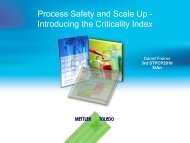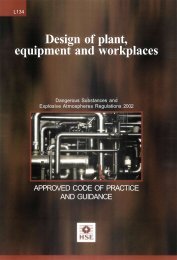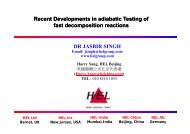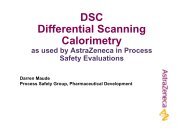Designing and operating safe chemical reaction processes HSG143
Designing and operating safe chemical reaction processes HSG143
Designing and operating safe chemical reaction processes HSG143
Create successful ePaper yourself
Turn your PDF publications into a flip-book with our unique Google optimized e-Paper software.
Health <strong>and</strong> SafetyExecutiveAppendix four:Emergency pressure reliefor vent design1 The design of emergency pressure relief systems for exothermic runaway iscomplex. It requires a thorough underst<strong>and</strong>ing of the <strong>reaction</strong> during runaway,including any side <strong>reaction</strong>s or unintended <strong>reaction</strong>s that may occur, <strong>and</strong> reliefsystem sizing methodology. You need information on:(a) the credible maloperations <strong>and</strong> system failures that might occur during <strong>reaction</strong>;(b) the kinetics of the <strong>reaction</strong> under runaway conditions;(c) whether the <strong>reaction</strong> pressure is from vapour or non-condensable gas (or both);(d) the flow regimes, both in the vessel <strong>and</strong> the relief system, during pressure relief;<strong>and</strong>(e) the design <strong>and</strong> layout of the relief system.Unless you use such information <strong>and</strong> apply it properly in the pressure relief systemdesign, then the system may not be correctly sized.2 The identification <strong>and</strong> characterisation of worst case scenarios have beendiscussed in paragraphs 149-152 of the main text.3 State-of-the-art techniques for vent design have been developed by theDesign Institute for Emergency Relief Systems (DIERS). A number of relief-systemsizing methods are available. 59 HSE has published a workbook 36 that givesinformation on methods available.What happens during relief?4 During an exothermic runaway the <strong>reaction</strong> temperature increasesexponentially. As the temperature increases the pressure in the reactor may alsoincrease. This can occur in three ways:(a) The pressure generated is due solely to the increasing vapour pressure of the<strong>reaction</strong> mass as the temperature increases - vapour pressure systems.(b) The pressure generated is due to a permanent gas - gassy systems. This canoccur in both synthesis <strong>and</strong> decomposition <strong>reaction</strong>s.(c) The pressure generated is due to both the vapour pressure <strong>and</strong> the permanentgas generation - hybrid systems.5 Vapour pressure systems <strong>and</strong> some hybrid systems are ‘tempered’. Providingthe relief system is large enough, the vapour generation allows sufficient latent heatof vaporisation to moderate the runaway. This holds the temperature constant <strong>and</strong>keeps the <strong>reaction</strong> rate approximately constant.6 Gassy systems are ‘untempered’ because there is no available mechanism forthe removal of significant amounts of heat from the vented system.<strong>Designing</strong> <strong>and</strong> <strong>operating</strong> <strong>safe</strong> <strong>chemical</strong> <strong>reaction</strong> <strong>processes</strong> Page 51 of 64










